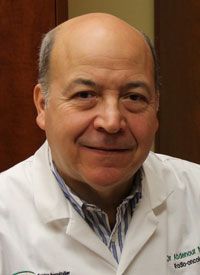Abbreviated Course of ADT + RT Produces Similar Outcomes, Improves QoL in High-Risk Prostate Cancer
When given along with radiation therapy to men with high-risk prostate cancer, 18 months of androgen-deprivation therapy (ADT)—as opposed to a 36-month course—not only generates similar long-term outcomes, but results in a better quality of life.
Abdenour Nabid, MD

Abdenour Nabid, MD
When given along with radiation therapy to men with high-risk prostate cancer, 18 months of androgen-deprivation therapy (ADT)as opposed to a 36-month course—not only generates similar long-term outcomes, but results in a better quality of life, according to a study presented Monday during the annual meeting of the American Society for Radiation Therapy (ASTRO), in San Francisco.
Authors Nabid et al had previously demonstratedin the multi-center, randomized, Canadian phase III PCS IV trial—that long-term outcomes in this high-risk population were similar using either ADT regimen, they noted in their abstract. They conducted the study presented at ASTRO to assess the men’s quality of life after testosterone recovery.
The investigators looked at data from 561 patients with high-risk prostate cancer, gleaned during PCS IV. About half of those patients received 18 months of ADT along with radiation therapy during the trial, while the other half received 36 months of ADT along with radiation therapy. In both groups, radiation therapy was started 4 months after ADT had begun.
To assess recovery time, each patient’s serum testosterone level was measured at baseline and at follow-up visits during a median 84 months. Testosterone was considered abnormal when it fell below the range designated as normal by the hospital laboratory conducting each individual assessment.
Among patients who received ADT for 18 months, 161 men (55.7%) recovered normal testosterone levels. Of those men who received ADT for 36 months, 122 (44.9%) recovered normal testosterone levels. Median time to testosterone recovery was shorter in the 18-month ADT group (47.2 months vs. 73.2 months), the authors reported.
The team evaluated quality of life by considering the men’s answers on two validated questionnaires. A 30-item questionnaire included queries about whether men had trouble taking a short walk, needed to stay in bed or a chair during the day, or felt depressed (EORTC30). A 25-item questionnaire asked whether men felt urinary urgency, had stool leakage, or experienced hot flashes (EORTC PR25). Patients filled out the questionnaires before treatment, every 6 months during ADT treatment, 4 months after completing ADT, and then once a year for 5 years. Patients whose prostate-specific antigen rose after treatment, indicating biochemical recurrence, started a new course of ADT and stopped filling out the questionnaires.
Men who recovered normal levels of testosterone reported a better quality of life. Among those men, answers to 28 out of 55 questionnaire items and 12 out of 21 questionnaire scales indicated a statistically significantly improved quality of life. Of those areas that reached statistical significance, 5 of 26 items and 1 of 21 scales were deemed clinically relevant, the authors reported.
“In high-risk prostate cancer treated with radiation therapy and ADT, patients who recover a normal testosterone level have a significantly better quality of life,” the authors concluded. “There is a major advantage for the use of 18-month ADT versus 36-month ADT, since a higher proportion of patients recover a normal testosterone level in a much shorter time without apparent detriment in long-term outcomes.”
Lead author Abdenour Nabid, MD, said in a statement released by ASTRO that, “The results of the analysis are not surprising considering the side effects of ADT, and that testosterone recovery has significant impact on patients’ improved quality of life.” Nabid is a radiation oncologist at Centre Hospitalier Universitaire de Sherbrooke and an associate professor at the University of Sherbrooke in Quebec, Canada. “In high-risk prostate cancer, the current guideline for ADT duration is between 2 and 3 years. Because of improvement in testosterone recovery and quality of life, a good first step could be to choose ADT for 2 years until we obtain the final results of the ongoing phase III PCS IV trial, which compares 18 months of ADT to 36 months of ADT.”
Nabid A, Carrier N, Martin A, et al. Quality of life in patients with testosterone recovery after long term androgen deprivation therapy for high risk prostate cancer. Presented at: the 56thAnnual Meeting of the American Society for Radiation Therapy; September 14-17, 2014; San Francisco, California. Abstract 24.
<<<